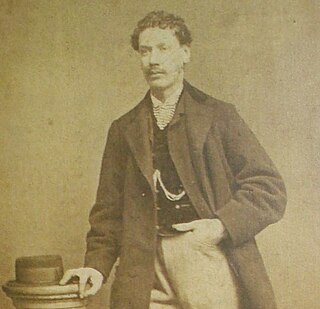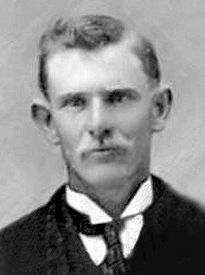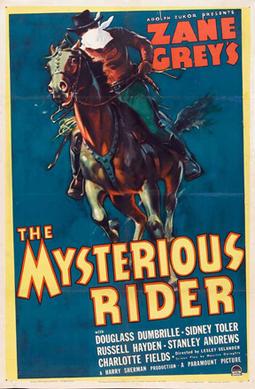Early life and notoriety
He was born J. William Standifer in Burnet County, Texas, and raised in Lampasas County, Texas, working cattle. By the age of 14, he was working regularly as a cowboy. That year, when he came across four men rustling cattle, he was pistol whipped by the men and badly hurt, but survived. Despite his youth, he tracked all four men, and killed them one by one. Although charges were pursued, he was acquitted.
In April 1879, Standifer was working as a cowboy on the Ike Mullins Ranch, in Tom Green County, Texas, where he came into contact with another cowboy, John McMahon, sometimes called John Mahon. The two found themselves involved in an argument when Standifer refused to allow McMahon to drive cattle across a pasture where Standifer was holding several head of Mullin's cattle. McMahon produced a bullwhip, while a companion pointed a rifle at Standifer, then McMahon began whipping Standifer. Both men were mounted, and Standifer was able to ride away to escape. Days later, Standifer tracked McMahon to a cattle camp near Pony Creek, located in Coleman County. As Standifer rode up, McMahon was mounted talking with several other cowboys. Upon seeing Standifer, McMahon drew his pistol and fired, but missed. Standifer drew and fired also, hitting McMahon in the wrist, causing his pistol to fall from his grip. McMahon spun his horse and galloped away, with Standifer in pursuit. The two made it about 600 yards from where the shootout began, with Standifer shooting McMahon again in the back, knocking him from his saddle. McMahon scrambled to his feet and attempted to run, but was again shot in the back, killing him.
Standifer fled, making it to Marfa, Texas, where he became involved in a saloon argument with three soldiers from Fort Davis, during which he shot and wounded two of them, before fleeing. Members of the Texas Rangers hunted Standifer down for the McMahon killing, and arrested him. However he was acquitted in a trial. Those shootings led to Standifer becoming known as a "gunman", and helped him in gaining employment as a Range Detective.
Lawman career, feud with John Higgins
By the early 1880s, Standifer was working as a Range Detective, tracking down rustlers, and is known to have shot and killed at least one rustler near Estacado, Texas. When the demand for his services dwindled, Standifer ran and was elected as County Sheriff for Crosby County, Texas from 1888 through 1894. While serving as Sheriff, in 1891, he and Deputy Charlie Quillen pursued a group of Post Office thieves into Lincoln County, New Mexico, where they captured them.
On the return trip to Texas, while staying over at the VVN Ranch owned by George Neal, the outlaws attempted to overpower him and Deputy Quillen. The deputy was shot and wounded in the chest with his own rifle, but was able to wrestle the outlaw to the floor and overpower him. The shot had also wounded George Neal's wife. Standifer, who was outside tending the horses, heard the wife scream, and ran inside. Another of the outlaws had acquired Standifer's shotgun, but when Standifer entered, the shotgun misfired. Standifer beat the suspect into submission, then assisted Deputy Quillen. That same night he shackled all three outlaws, and rode with them and Quillen to the nearest doctor. Deputy Quillen survived, and the two were later able to take their prisoners on to Texas.
In 1893 he began working again as a Range Detective for large and prosperous ranches in the Texas Panhandle, mainly the powerful Spur Ranch, located in Spur, Texas, where he first met John "Pink" Higgins, a notable gunman already known to Standifer, since they were both from Lampasas, Texas. Standifer quickly gained a reputation for being an excellent tracker, and for always locating his prey. In June 1898, while tracking rustlers, Standifer arrived in Clairemont, Texas, a rough town at the time, and the location in which Jeff Hardin, brother to gunman John Wesley Hardin, had been shot and killed. Standifer located a rustler named Bob Kiggins there, but Kiggins refused to surrender, and in the gunfight that followed Standifer shot and killed Kiggins.
During this period, an animosity between Standifer and Higgins developed, one that has never truly been explained. It has been written that the Horrell Brothers, who were brought down mostly through the efforts of "Pink" Higgins, and who were distant kin to Standifer, were part of the problems between them. However, it is more likely that it was due to Higgins' son, Cullin, an attorney, who had represented Standifer's wife in her divorce from him. Fred Horsbrugh, manager of the Spur Ranch, fired both Higgins and Standifer due to the increasing hostilities between them. However, Horsbrugh allowed Higgins to stay on for a time after this, until he could find another job. This angered Standifer. In 1900, Standifer moved to Hartley County, Texas, where he was elected Sheriff.
At one point, just prior to Higgins leaving the Spur Ranch, he was dispatched to investigate a possible cattle rustling on a remote section of the ranch. Making a circular approach, Higgins spotted Standifer waiting in a group of trees. Rather than approach him, and knowing he was there to ambush him, Higgins simply went home. However, the animosity continued. On the morning of October 4, 1903, after having made comments that he would kill Higgins, Standifer rode out to Higgins' ranch. Higgins, seeing him from his house, rode out to meet him. Higgins' brother-in-law and daughter were standing on a hillside nearby, and witnessed what happened next. Standifer fired first, hitting Higgins' horse, which then jerked, causing Higgins' first shot to go wild. In the shooting exchange that followed, Standifer was shot and killed. Higgins' horse also died.
Higgins then retrieved another horse, and contacted Sheriff B. F. Roy, in Clairemont. When Higgins told Sheriff Roy that he believed he had killed Standifer, Sheriff Roy, who disliked Standifer for reasons unknown, stated "Well if you're not sure, you'd better go and finish the job". The shooting was ruled justifiable homicide, and Higgins was never arrested or tried. He buried Standifer himself, on the Higgins property, naming the thicket where he is buried "Standifer's Thicket".

The Johnson County War, also known as the War on Powder River and the Wyoming Range War, was a range conflict that took place in Johnson County, Wyoming from 1889 to 1893. The conflict began when cattle companies started ruthlessly persecuting alleged rustlers in the area, many of whom were settlers who competed with them for livestock, land and water rights. As violence swelled between the large established ranchers and the smaller settlers in the state, it culminated in the Powder River Country, when the ranchers hired gunmen, who invaded the county. The gunmen's initial incursion in the territory alerted the small farmers and ranchers, as well as the state lawmen, and they formed a posse of 200 men that led to a grueling standoff which ended when the United States Cavalry on the orders of President Benjamin Harrison relieved the two forces, although further fighting persisted.

William Brocius, better known as Curly Bill Brocius, was an American gunman, rustler and an outlaw Cowboy in the Cochise County area of the Arizona Territory during the late 1870s and early 1880s. His name is likely an alias or nickname, and some evidence links him to another outlaw named William "Curly Bill" Bresnaham, who was convicted of an 1878 attempted robbery and murder in El Paso, Texas.

Harvey Alexander Logan, also known as Kid Curry, was an American outlaw and gunman who rode with Butch Cassidy and the Sundance Kid's infamous Wild Bunch gang during the late 19th and early 20th centuries. Despite being less well-known than his fellow gang members, he has since been referred to as "the wildest of the Wild Bunch", having reputedly killed at least nine law enforcement officers in five shootings and another two men in other instances. He was involved in numerous shootouts with police and civilians and participated in several bank and train robberies with various gangs during his outlaw days.

Commodore Perry Owens was an American lawman and gunfighter of the Old West. One of his many exploits was the Owens-Blevins Shootout in Arizona Territory during the Pleasant Valley War.

Josiah Gordon "Doc" Scurlock was an American Old West figure, cowboy, and gunfighter. A founding member of the Regulators during the Lincoln County War in New Mexico, Scurlock rode alongside such men as Billy the Kid.
The Jesse Evans Gang, also known as The Boys, was a gang of rustlers and robbers led by outlaw and gunman Jesse Evans, which lasted from 1876 until 1880. The gang was formed after Evans broke with the John Kinney Gang. After breaking away, he brought along with him Billy Morton, Frank Baker, Tom Hill, Dolly Graham, George Davis, Jim McDaniels, Buffalo Bill Spawn, Bob Martin, Manuel "Indian" Segovia and Nicholas Provencio.
David Lawrence Anderson was a 19th-century American outlaw, better known under the alias Billy Wilson, who rode with Billy the Kid following the Lincoln County War. In his later years, he also served as a law enforcement officer and a U.S. customs inspector.

George Washington Coe (1856–1941) was an Old West cowboy and a gunman during the Lincoln County War.
The Horrell brothers, sometimes referred to as the lawless Horrell boys, were five brothers from the Horrell family of Lampasas County, Texas, who were outlaws of the Old West, and who committed numerous murders over a five-year period before four of the brothers were killed in different incidents. The brothers are probably best known for the Horrell-Higgins feud, although it resulted in relatively few deaths compared to other feuds. However, starting in 1873, the brothers went on an ethnically motivated killing spree during which they killed a Hispanic lawman and a white lawman in New Mexico, killed 11 other Hispanic men, and wounded one Hispanic woman. The brothers had previously killed five lawmen in Texas.
John Pinckney Calhoun Higgins, better known as "Pink" Higgins, was a gunman and cowboy of the Old West. He is known to have killed 14 men in his lifetime.

The Mysterious Rider is a 1938 American Western film directed by Lesley Selander and starring Douglass Dumbrille, Sidney Toler, and Russell Hayden. Written by Maurice Geraghty based on the 1921 novel The Mysterious Rider by Zane Gray, the film is about a notorious outlaw who returns to the ranch he once owned and takes a job disguised as a ranch hand. Unrecognized by the ranch's current owner, he waits patiently for an opportunity to expose the men who murdered his partner twenty years ago, framed him for the crime, and then stole his ranch. The film was later released for television in the United States as Mark of the Avenger.

Public Cowboy No. 1 is a 1937 American Western film directed by Joseph Kane and starring Gene Autry, Smiley Burnette, and Ann Rutherford. Based on a story by Bernard McConville, the film is about a singing cowboy who chases down rustlers who are using airplanes, shortwave radios, and refrigerated trucks to steal cattle.
Fuzzy Settles Down is a 1944 American Western film directed by Sam Newfield.

The Cochise County Cowboys is the modern name for a loosely associated group of outlaws living in Pima and Cochise County, Arizona in the late 19th century. The term "cowboy", as opposed to "cowhand," had only begun to come into wider usage during the 1870s. In that place and time, "cowboy" was synonymous with "cattle rustler". Such thieves frequently rode across the border into Mexico and stole cattle from Mexican ranches that they then drove back across the border to sell in the United States. Some modern writers consider them to be an early form of organized crime in America.

Cochise County in southeastern Arizona was the scene of a number of violent conflicts in the 19th-century and early 20th-century American Old West, including between white settlers and Apache Indians, between opposing political and economic factions, and between outlaw gangs and local law enforcement. Cochise County was carved off in 1881 from the easternmost portion of Pima County during a formative period in the American Southwest. The era was characterized by rapidly growing boomtowns, the emergence of large-scale farming and ranching interests, lucrative mining operations, and the development of new technologies in railroading and telecommunications. Complicating the situation was staunch resistance to white settlement from local Native American groups, most notably during the Apache Wars, as well as Cochise County's location on the border with Mexico, which not only threatened international conflict but also presented opportunities for criminal smugglers and cattle rustlers.

The Battleground Gunfight, also known as the Battleground Shootout, was a gunfight between a posse of American lawmen and the Smith Gang. It was fought on October 8, 1901, within Arizona Territory's Fort Apache Indian Reservation, at a clearing in the forest known today as the "Battleground". Nine Arizona Rangers and deputies caught up with the cattle rustler Bill Smith and his gang. During a long exchange of gunfire that followed, Ranger Carlos Tafolla and Deputy Bill Maxwell were killed and one or two of the outlaws may have been wounded. In the end, the Smith Gang escaped the posse and fled into Mexico.

Feuds in the United States deals with the phenomena of historic blood feuding in the United States. These feuds have been numerous and some became quite vicious. Often, a conflict which may have started out as a rivalry between two individuals or families became further escalated into a clan-wide feud or a range war, involving dozens—or even hundreds—of participants. Below are listed some of the most notable blood feuds in United States history, most of which occurred in the Old West.
Kiggins is an Anglicized spelling of the Irish surname Mag Uiginn, or "son of the Viking," and may refer to:
Matt Warner was a notable figure from the American Old West who was a farmer, cowboy, rancher, ferryman, cattle rustler, bank robber, justice of the peace, lawman, and bootlegger. Born Erastus Christiansen, he changed his name in his teens when he became an outlaw.

Isam Dart, also known as Isom, was a cattle driver, rancher, and horse and cattle rustler during the late 19th century in the Wild West. He settled in Browns Park in northwestern Colorado, where he was considered by his neighbors to be a "superlative rider and roper, a good neighbor, and an expert and industrious cattle thief." He and his partner Mat Rash were gunned down in separate events and were believed to have been assassinated by Tom Horn, a hired gunman.












